Special Programmes
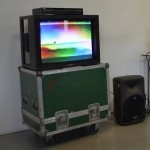 Christopher King – Video Circuits analogue video synthesis retrospective
Christopher King – Video Circuits analogue video synthesis retrospective
Video Circuits is a blog and research project that takes a wide ranging approach to documenting the early years of electronic video art, visual music and computer art with a view to informing the current output of contemporary artists and musicians working in the field. This screening will showcase work from a range of new and established artists who are part of the video circuits community from around the world.
Ian Helliwell Programme
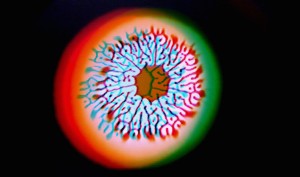 Travelling Waveforms (2013), Escape the Light (2014) and Molecular Feedback (2014) – 3 short films which display Ian Helliwell’s work with abstraction, light, video feedback, sound visualisation and electronic music.
Travelling Waveforms (2013), Escape the Light (2014) and Molecular Feedback (2014) – 3 short films which display Ian Helliwell’s work with abstraction, light, video feedback, sound visualisation and electronic music.
Since the early 1990s Helliwell has been building his own analogue tone generators and synthesizers to make electronic music. In this same period he has completed more than 100 short experimental films, and has used his ‘Hellitrons’ and ‘Hellisizers’ to make the electronic soundtracks. His ongoing experiments with abstraction and animation, include a series of sound visualisation films. These incorporate images generated by modified and self-built circuitry, and manipulated super 8 footage, and use electronic or found sounds to directly activate or influence the moving image.
His series of light and colour based abstract films begun in 1998, have continued with the exploration of distorted and refracted light, fused with electronic music soundtracks. Escape the Light and Travelling Waveforms include super 8 film modified with household bleach, which reacts with the film emulsion to create various visual effects. Starting in 2010, Helliwell has been experimenting with video feedback, and developed his own Hellicam, specifically for generating abstract images. Made from a child’s karaoke toy, the camera allows for greater control of movement, and lends itself to a simple form of sculpting with light.
Biography
 A self-taught multi-media artist living in Brighton since 1985, Helliwell has amassed a large body of work through a synthesis of analogue and digital equipment, using various hands-on techniques to realise his ideas. His intuitive approach embraces both antiquated and contemporary technology, and his many years of audio-visual experience incorporates music, film, animation, analogue electronics, instrument building, collage, installations, light show projection, live performance, writing and film programming.
A self-taught multi-media artist living in Brighton since 1985, Helliwell has amassed a large body of work through a synthesis of analogue and digital equipment, using various hands-on techniques to realise his ideas. His intuitive approach embraces both antiquated and contemporary technology, and his many years of audio-visual experience incorporates music, film, animation, analogue electronics, instrument building, collage, installations, light show projection, live performance, writing and film programming.
He has made over 100 short experimental films screened worldwide, and years of experimentation with building and modifying 9v circuitry, has led to the design and construction of his unique series of Hellisizer synths and Hellitron tone generators, used to make the soundtracks to nearly all his films.
He has a long held interest in abstract animation, world’s fairs and electronic music, and his first feature length documentary film, Practical Electronica, looking at FC Judd and early British tape recording, was completed in 2011. He is currently completing Tape Leaders, an A-Z book on early British electronic music composers, due for publication in the spring of 2016.
Fixed Media Works
Bret Battey, Hugi Guðmundsson – Triptych Unfolding (12:00)
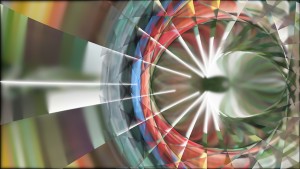 The Reykjavik Center for Visual Music commissioned “Triptych Unfolding” from Hugi Guðmundsson and Bret Battey for the opening concert of the RCVM – Punto y Raya Festival, January 30th, 2014, at the Harpa Concert Hall, Reykjavík, Iceland. Both artists saw the commission as an opportunity to challenge their standard working methods and styles. The starting point for the work was an agreement to seek a “spacious, excellent simplicity” in the materials and their development. Guðmundsson composed the music — for realtime computer processing of piano — based on initial animated visual sketches developed with Battey during a two-day session in July, 2013. Battey then redeveloped the visual part and created the necessary software to perform it live with the music. This allows the pianist, Guðmundsson (running the sound processing) and Battey to interact fluidly and spontaneously as chamber music performers. Seeing Sound is presenting a fixed-media version.
The Reykjavik Center for Visual Music commissioned “Triptych Unfolding” from Hugi Guðmundsson and Bret Battey for the opening concert of the RCVM – Punto y Raya Festival, January 30th, 2014, at the Harpa Concert Hall, Reykjavík, Iceland. Both artists saw the commission as an opportunity to challenge their standard working methods and styles. The starting point for the work was an agreement to seek a “spacious, excellent simplicity” in the materials and their development. Guðmundsson composed the music — for realtime computer processing of piano — based on initial animated visual sketches developed with Battey during a two-day session in July, 2013. Battey then redeveloped the visual part and created the necessary software to perform it live with the music. This allows the pianist, Guðmundsson (running the sound processing) and Battey to interact fluidly and spontaneously as chamber music performers. Seeing Sound is presenting a fixed-media version.
Biographies
Hugi Gudmundsson (Iceland, 1977) studied composition at Reykjavik College of Music with Thorkell Sigurbjörnsson and Úlfar Ingi Haraldsson. In 2005 he finished a Masters degree in composition from the Royal Danish Academy of Music where he studied with Bent Sørensen, Hans Abrahamsen and Niels Rosing-Schow. He finished a second Masters degree (electronic music, Institute of Sonology, The Netherlands) spring 2007. He lives and works full-time as a composer in Copenhagen, Denmark.
 Bret Battey (b. 1967) creates electronic, acoustic, and multimedia concert works and installations. He has been a Fulbright Fellow to India and a MacDowell Colony Fellow, and he has received recognitions and prizes from Austria’s Prix Ars Electronica, France’s Bourges Concours International de Musique Electroacoustique, Spain’s Punto y Raya Festival and MuVi4, Abstracta Cinema of Rome, Amsterdam Film eXperience and the Texas Fresh Minds Festival for his sound and image compositions. He studied composition and electronic music at Oberlin Conservatory and the University of Washington and is a Reader with the Music, Technology, and Innovation Research Centre at De Montfort University, Leicester, UK.
Bret Battey (b. 1967) creates electronic, acoustic, and multimedia concert works and installations. He has been a Fulbright Fellow to India and a MacDowell Colony Fellow, and he has received recognitions and prizes from Austria’s Prix Ars Electronica, France’s Bourges Concours International de Musique Electroacoustique, Spain’s Punto y Raya Festival and MuVi4, Abstracta Cinema of Rome, Amsterdam Film eXperience and the Texas Fresh Minds Festival for his sound and image compositions. He studied composition and electronic music at Oberlin Conservatory and the University of Washington and is a Reader with the Music, Technology, and Innovation Research Centre at De Montfort University, Leicester, UK.
Myriam Boucher – Cité (10:39)
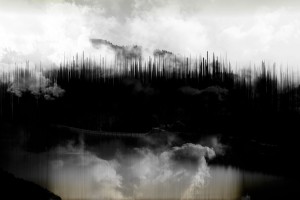 Material to digital cities.
Material to digital cities.
the world is reversed
inhabited space dies and reborn
ruin or dust
no matter
trace has resonance in us
a noise that lasts
Biography
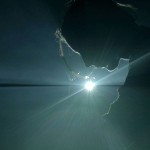 Myriam Boucher is a Montreal based video and sound artist. She has been part of different artistic projects on the North American music scee, from hers early experience as a keyboardist for various instrumental music projects through to hers visual work, she’s working on the intime dialogue between music and image.
Myriam Boucher is a Montreal based video and sound artist. She has been part of different artistic projects on the North American music scee, from hers early experience as a keyboardist for various instrumental music projects through to hers visual work, she’s working on the intime dialogue between music and image.
She creates videomusic, electroacoustic, mixed and intrumental music, performance and audiovisual installations. Her work was prized in the JTTP 2015 (CEC), JIM Electroacoustic Compositions 2015 Competition and Bourse Euterke 2015 and has been presented at many international events.
Jean Piché – Etude aux oiseaux (7:00)
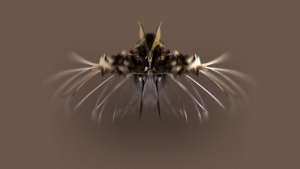 Étude aux oiseaux stars phantasmagoric feathered animals that strut and display their colours in a slightly deranged pavane. As in recent past works, the idea of synchronicity is questioned, aiming instead for a decoupling of audio/image relationships. The visuals are entirely generated with a 3-D meshing software and textured with landscape videos shot in South America. A longer version of the piece was originally scored for electric guitar and video, commissioned by guitar virtuoso Tim Brady. The present version is a fixed media re-cast of the original imagery.
Étude aux oiseaux stars phantasmagoric feathered animals that strut and display their colours in a slightly deranged pavane. As in recent past works, the idea of synchronicity is questioned, aiming instead for a decoupling of audio/image relationships. The visuals are entirely generated with a 3-D meshing software and textured with landscape videos shot in South America. A longer version of the piece was originally scored for electric guitar and video, commissioned by guitar virtuoso Tim Brady. The present version is a fixed media re-cast of the original imagery.
Biography
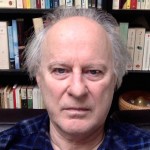 Jean Piché is a composer, media artist and software designer living in Montreal, Canada. who has been active in computer music since the emergence of the field in the 1970s. While his practice has been devoted to videomusic, a hybrid alloy of music and moving images, he is currently invested in physical systems as performance instruments and installations. His work aims for poetic expression beyond any avowed formalism. As a music software designer he is the creator of novel applications, amongst them Cecilia. He teaches at the Université de Montréal and is Associate director of CIRMMT, the renowned music and media research center at McGill University.
Jean Piché is a composer, media artist and software designer living in Montreal, Canada. who has been active in computer music since the emergence of the field in the 1970s. While his practice has been devoted to videomusic, a hybrid alloy of music and moving images, he is currently invested in physical systems as performance instruments and installations. His work aims for poetic expression beyond any avowed formalism. As a music software designer he is the creator of novel applications, amongst them Cecilia. He teaches at the Université de Montréal and is Associate director of CIRMMT, the renowned music and media research center at McGill University.
Matthew Schoen – Vehicles (9:30)
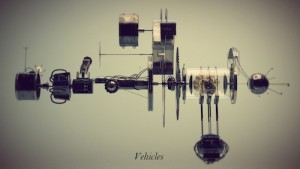 Vehicles is video and sound work in which an imagined structure is revealed from its smallest components to the larger and more complex entities they compose. The accompanying music and sound reinforce a narrative ranging from a place of intimacy to a growing vastness, while echoing the visual content of the video. This work is loosely inspired from the essay Vehicles written by Italian-Austrian cyberneticist Valentino Braitenberg.
Vehicles is video and sound work in which an imagined structure is revealed from its smallest components to the larger and more complex entities they compose. The accompanying music and sound reinforce a narrative ranging from a place of intimacy to a growing vastness, while echoing the visual content of the video. This work is loosely inspired from the essay Vehicles written by Italian-Austrian cyberneticist Valentino Braitenberg.
Biography
 The work of Montreal artist and composer Matthew Schoen extends towards various media such as video, installation, and electroacoustic music. A desire to renew audience experience while blurring the lines between music, sound art and visual arts has accompanied his recent creative process. Thus, he has presented his works by means of live audiovisual performances, installations, video screenings, and immersive sound diffusion. He is a regular contributor to Montreal’s AKOUSMA festival as well as Montreal’s Code d’accès concert series. He was also recently featured at the San Francisco Tape Music Festival, the International Symposium on Electronic Art in Vancouver (ISEA) and the Miami New Media Festival. He has previously collaborated with dance and theater productions and is a founding member of Montreal’s Soundwich concert series, promoting young talent in experimental music. Last year, he completed his postgraduate studies in Electroacoustic Composition at the Montreal Music Conservatory under composer Louis Dufort.
The work of Montreal artist and composer Matthew Schoen extends towards various media such as video, installation, and electroacoustic music. A desire to renew audience experience while blurring the lines between music, sound art and visual arts has accompanied his recent creative process. Thus, he has presented his works by means of live audiovisual performances, installations, video screenings, and immersive sound diffusion. He is a regular contributor to Montreal’s AKOUSMA festival as well as Montreal’s Code d’accès concert series. He was also recently featured at the San Francisco Tape Music Festival, the International Symposium on Electronic Art in Vancouver (ISEA) and the Miami New Media Festival. He has previously collaborated with dance and theater productions and is a founding member of Montreal’s Soundwich concert series, promoting young talent in experimental music. Last year, he completed his postgraduate studies in Electroacoustic Composition at the Montreal Music Conservatory under composer Louis Dufort.
Vibeke Sorensen, Kartik Seshadri – Mayur (7:42)
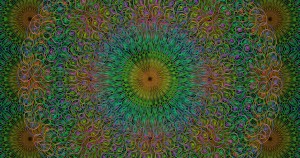 Mayur (2015, 7:42) is an abstract computer animated visual musical work inspired by Indian ragas, textiles, symbols, and cosmologies. The animation is by Vibeke Sorensen with music by sitar virtuoso Kartik Seshadri.
Mayur (2015, 7:42) is an abstract computer animated visual musical work inspired by Indian ragas, textiles, symbols, and cosmologies. The animation is by Vibeke Sorensen with music by sitar virtuoso Kartik Seshadri.
Biographies
 Vibeke Sorensen is an artist, composer, and professor working in digital multimedia and animation, stereography, interactive architectural installation, and networked visual music performance. Her work in experimental new media spans more than four decades and has been published and exhibited worldwide, including in books, galleries, museums, conferences, performances, film festivals, on cable and broadcast television, and the internet.
Vibeke Sorensen is an artist, composer, and professor working in digital multimedia and animation, stereography, interactive architectural installation, and networked visual music performance. Her work in experimental new media spans more than four decades and has been published and exhibited worldwide, including in books, galleries, museums, conferences, performances, film festivals, on cable and broadcast television, and the internet.
Since 1980, she taught and developed programs in media art at Virginia Commonwealth University, Art Center College of Design, California Institute of the Arts, and Princeton University. From 1984-94, she was Founding Director of the Computer Animation Laboratory in the School of Film/Video at the California Institute of the Arts (CalArts), and from 1994-2005 she was Professor and Founding Chair of the Division of Animation and Digital Arts (DADA) in the School of Cinematic Arts at the University of Southern California (USC). Since 2009, she has been Professor and Chair of the School of Art, Design and Media (ADM) at Nanyang Technological University (NTU) in Singapore.
Vibeke Sorensen has a long history of interdisciplinary collaborations, art-science and art-engineering interactions, including the development of new media technologies at Rensselaer Polytechnic Institute, Princeton University, the University of Southern California, the University of California San Diego / San Diego Supercomputer Center, the Neurosciences Institute of La Jolla, and the California Institute of Technology. Her research and creative work has been supported by USC, NTU, the New York State Council on the Arts, the US National Science Foundation, and Intel Corporation, among others. She is a 2001 Rockefeller Foundation Fellow in Film/Video/Multimedia. In 2007 she was the Chair of the ACM SIGGRAPH Art Gallery: Global Eyes.
Her recent work Illuminations (2013) is a large scale illuminated folding screen, an interactive visual-music installation incorporating plant biofeedback, ubiquitous computing, and electro-acoustic music that she composed. Vishwaroop (2014) is a 4K generative dome animation with music by sitar virtuoso Kartik Seshadri, and Mood of the Planet (2015) is a kinetic light-sound sculpture incorporating global, real-time big data, Twitter, and music composed by Sorensen. Her most recent work, Mayur (2015), with music by Kartik Seshadri, is a 4K animation inspired by Asian textiles, symbols, and cosmologies.
Kartik Seshadri
Pandit Kartik Seshadri is a world-renowned force in the field of Indian Classical Music. As a sitarist, he attracted widespread attention when he began performing full-length solos at the age of 6 in India. The sitar maestro is now hailed as an “amazingly accomplished” musical powerhouse noted for his music’s “expressive beauty, rich tonal sensibility, and rhythmic intricacy,” praised the Washington Post while the Times of India (2011) noted that Seshadri’s concert was “a show stopper that transported the audience to soak soul deep in his mesmerizing performance.” The prestigious Songlines Magazine (U.K.) has in its March 2012 issue declared his latest album “Sublime Ragas” as one of the “Top Ten of the World’s ” CD’s (as with his 2004 Raga:Rasa album) further citing him as one of the “world’s greatest sitar players.”
kartikseshadri.com/biography/#sthash.lNSoHJWh.dpuf
Luigi Allemano – Improvisation No. 1: Cumulative Loops (3:20)
 Improvisation no. 1: Cumulative Loops is the audio-visual artifact of an improvisation in hand-drawn animation and musical collage. Visual riffs drawn on paper strips are digitized and assembled additively with musical phrases taken from the artist-composer’s collection of unused film score and sound effects recordings, 16mm optical scratch tracks and extemporaneous instrumental performances. Playing with the concomitance of image and sound, the work transposes the conditions of musical performance to the incremental process of animation, forming an idiosyncratic way of generating and experiencing rhythm, movement, duration and time.
Improvisation no. 1: Cumulative Loops is the audio-visual artifact of an improvisation in hand-drawn animation and musical collage. Visual riffs drawn on paper strips are digitized and assembled additively with musical phrases taken from the artist-composer’s collection of unused film score and sound effects recordings, 16mm optical scratch tracks and extemporaneous instrumental performances. Playing with the concomitance of image and sound, the work transposes the conditions of musical performance to the incremental process of animation, forming an idiosyncratic way of generating and experiencing rhythm, movement, duration and time.
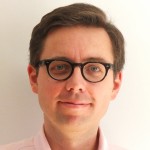 Biography
Biography
Luigi Allemano is a Montreal-based animation filmmaker, composer and sound designer. His work appears in more than sixty productions of the National Film Board of Canada, four of which have received Academy Award nominations. Allemano is a faculty member of Concordia University’s Mel Hoppenheim School of Cinema.
Francesc Marti – Speech 2 (7:54)
 Speech 2 is an experimental audiovisual piece created from a series of old clips from the US broadcast public affairs interview program The Open Mind. This piece is reflection on the action of communicating, highlighting its limitations, and can be labelled as “text-sound-art”, or “text-sound-composition” in an audio-visual framework.
Speech 2 is an experimental audiovisual piece created from a series of old clips from the US broadcast public affairs interview program The Open Mind. This piece is reflection on the action of communicating, highlighting its limitations, and can be labelled as “text-sound-art”, or “text-sound-composition” in an audio-visual framework.
Technically, in this piece, the author has been experimenting how granular sound synthesis techniques, in particular synchronous granular synthesis, can be used for audiovisual creative works. The original movies are altered and manipulated, generating new images and sonorities. All the piece sounds and images come from that series of clip, in other words, no other sound samples or images have been used to create the final result.
Biography
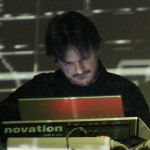 Francesc Martí is a mathematician, computer scientist, composer, sound and digital media artist born in Barcelona and currently living in the UK. He has a bachelor’s degree in Mathematics from the Autonomous University of Barcelona, and two master’s degrees, one from the Pompeu Fabra University in Digital Arts, and the other in Free Software from the Open University of Catalonia. He also obtained a scholarship for furthering his studies in Music Technology at IRCAM (Paris). Simultaneously, he studied music at the Conservatory of Sabadell, where he obtained the Professional Title of Piano with honours.
Francesc Martí is a mathematician, computer scientist, composer, sound and digital media artist born in Barcelona and currently living in the UK. He has a bachelor’s degree in Mathematics from the Autonomous University of Barcelona, and two master’s degrees, one from the Pompeu Fabra University in Digital Arts, and the other in Free Software from the Open University of Catalonia. He also obtained a scholarship for furthering his studies in Music Technology at IRCAM (Paris). Simultaneously, he studied music at the Conservatory of Sabadell, where he obtained the Professional Title of Piano with honours.
As composer and video artist, his works have been performed or exhibited all over the world, including international festivals, events and exhibitions. In 2001 he founded the experimental electronic music project RMSonce, with which have garnered many positives reviews from around the world.
In 2014 he starts his project “Granular synthesis video”, with which he has already participated in more than 30 exhibitions and concerts around the world, including China, Brazil, USA, Russia, Argentina, Mexico, UK, Scotland, The Netherlands, Spain, France, Ireland, Germany and Italy.
Currently, he combines his artistic and technology projects with his teaching Audio Technology and Image at Open University of Catalonia, and Music Technology at the De Montfort University of Leicester (UK).
Christian Eloy, Krunoslav Pticar – Soupir Bleu (6:00)
 … some blue … some sounds … some breaths …
no story, only your own story with blue and breaths !
Soupir bleu is born from a very free interpretation of Marc Vappereau’s installation at Sous La Tente gallery in Bordeaux.
… some blue … some sounds … some breaths …
no story, only your own story with blue and breaths !
Soupir bleu is born from a very free interpretation of Marc Vappereau’s installation at Sous La Tente gallery in Bordeaux.
I was very happy to be completly free to compose a full electroacoustic music on this very personnal video of Krunoslav. I didn’t ask any information about the original idea or the story of this installation; I was fascinated by an aesthetic reading of this video and I wanted to make a music translating this very intimate emotion.
Biography
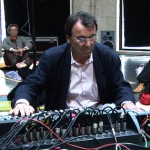 Born in Amiens where he studied flute and composition at the conservatoire national of region and then at the conservatoire superior of Paris.
Born in Amiens where he studied flute and composition at the conservatoire national of region and then at the conservatoire superior of Paris.
Flutist in an orchestra , then director of a music school, before his meeting with Electroacoustic music, GRM at Radio France, Ivo Malec and IRCAM.
In charge for 24 years of the electroacoustic department of the Conservatoire in Bordeaux and the workshop at the Groupe de Recherches Musicales /City of Paris for 17 years. Lecturer in the universities of Paris IV (Sorbonne) and Bordeaux III.
Christian ELOY is the co-founder and artistic director of the SCRIME, research and creation studio in the university of Bordeaux I. Several awards : prize of the europeen community poetry and music – prize “ François de Roubaix “. Composer of over sixty pieces, instrumental, electroacoustic, vocal and pedagogical. His music was played in many countries, UK, Quebec, US, China, Taiwan, Japan, Poland, Italy, Germany, Denmark, Spain, Belgium. Published by Billaudot, Fuzeau, Lemoine, Combre, Notissimo, Temperaments and Jobert. Publications at PUF (France), Johnston Ed.(Irlande), MIT press (US), Le mensuel littéraire et poétique (Belgique). Confluences (France). CD Ina-GRM DDD771 – IMEB Compendium 2004 – IMEB Compendium 2005 – Octandre 1001 – Octandre 1002.
Fernando Falci de Souza – Belly Trick (10:00)
 In this work we applied audiovisual granular synthesis in the creation of four short episodes using natural and urban audiovisualscapes of Bristol (UK). By splicing and reorganizing fragments of audio recordings, photographs and videos, captured by the author during his one-year experience of the place, textures are reconstructed with some variable degree of resemblance to the original object. The episodes are inspired in specific elements: nature, underground, bike rides and farewell. In each episode, the external elements are arranged to reproduce a specific mood according to its significance to the author and therefore the creative process is intuitively guided by a combination of outer and inner-world elements of perception, memory and cognition.
In this work we applied audiovisual granular synthesis in the creation of four short episodes using natural and urban audiovisualscapes of Bristol (UK). By splicing and reorganizing fragments of audio recordings, photographs and videos, captured by the author during his one-year experience of the place, textures are reconstructed with some variable degree of resemblance to the original object. The episodes are inspired in specific elements: nature, underground, bike rides and farewell. In each episode, the external elements are arranged to reproduce a specific mood according to its significance to the author and therefore the creative process is intuitively guided by a combination of outer and inner-world elements of perception, memory and cognition.
Biography
 I am an artist/researcher of Visual Music. Doctor and Master in Music at University of Campinas in the area of Technological Interfaces for Musical Processes. I performed internships at the Centre for Musical Research, Bath Spa University (England), on Creative Processes for Granular Visual Music, supported by Research Internships Abroad Program (FAPESP), and twice at the Input Devices for Music Interaction Lab, McGill University (Canada), on Design and Creation of Digital Musical Instruments, supported by Emerging Leaders at the Americas Program (ELAP) and International Mobility Grant of Santander Universities Program. Due to my interdisciplinary training, with degrees in Computer Science (University of Sao Paulo) and in Popular Music (Santa Marcelina College), I like to develop most of the technologies used to create fixed media, performances and installations. In my research, I investigate the correlations between sound, music, image and abstract animation, exploring alternative ways to use digital technology and electronic sensors. My works were presented in several national and international academic events such as “Seeing Sound”, “Understanding Visual Music”, “Brazilian Symposium on Computer Music” and “Brazilian Meeting of University Composers”, as well as in informal events like “I Hear Colours Man” (Bristol, UK), “Pandora’s House” and “IBRASOTOPE Concerts of Experimental Music” (Sao Paulo, BR).
I am an artist/researcher of Visual Music. Doctor and Master in Music at University of Campinas in the area of Technological Interfaces for Musical Processes. I performed internships at the Centre for Musical Research, Bath Spa University (England), on Creative Processes for Granular Visual Music, supported by Research Internships Abroad Program (FAPESP), and twice at the Input Devices for Music Interaction Lab, McGill University (Canada), on Design and Creation of Digital Musical Instruments, supported by Emerging Leaders at the Americas Program (ELAP) and International Mobility Grant of Santander Universities Program. Due to my interdisciplinary training, with degrees in Computer Science (University of Sao Paulo) and in Popular Music (Santa Marcelina College), I like to develop most of the technologies used to create fixed media, performances and installations. In my research, I investigate the correlations between sound, music, image and abstract animation, exploring alternative ways to use digital technology and electronic sensors. My works were presented in several national and international academic events such as “Seeing Sound”, “Understanding Visual Music”, “Brazilian Symposium on Computer Music” and “Brazilian Meeting of University Composers”, as well as in informal events like “I Hear Colours Man” (Bristol, UK), “Pandora’s House” and “IBRASOTOPE Concerts of Experimental Music” (Sao Paulo, BR).
Harvey Goldman, Jing Wang – Passahhdi (9:09)
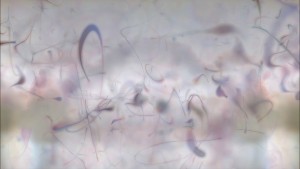 Lost in tranquility, the ethereal sounds and imagery of the inner mind struggle to maintain their primal elegance, as turbulence from the world beyond begins to infringe on their domain. The transcendent inner soundscapes of the imagination are ever vigilant as they rumble with the vestiges of human endeavor.
Lost in tranquility, the ethereal sounds and imagery of the inner mind struggle to maintain their primal elegance, as turbulence from the world beyond begins to infringe on their domain. The transcendent inner soundscapes of the imagination are ever vigilant as they rumble with the vestiges of human endeavor.
Passahhdi is an abstract experimental animation.A melding of sound and image that explores both the emotional relationships and the commonalityof their formal language. The manner in which the elemental components of the underlying structure, such as line, shape, color/timbre and form, as well as principals, such as harmony, balance, rhythm, and counterpoint, translate between the auditory and visual experience is a primary concern.
Biographies
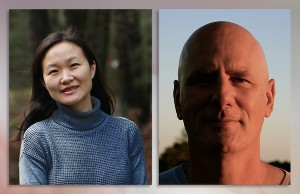 Jing Wang, a composer and virtuoso erhu artist, was born in China. Ms. Wang has participated in numerous musical communities, as a composer and a performer of diverse styles of music. Her compositions have been selected and presented in China, Spain, France, Italy, Serbia, Turkey, Romania, Russia, Australia, Japan, Argentina, and throughout the United States. They have also been recognized by the American Society of Composers, Authors, and Publishers and Electro-acoustic Miniatures International Contest Spain. She was the winner of 2006 Pauline Oliveros Prize given by the International Alliance for Women in Music and has been awarded the MacDowell Colony Fellowship, the Vilcek Foundation Fellowship, and the Omi International Musicians Residency Fellowship. As an active erhu performer, she has introduced the Chinese indigenous erhu into Western contemporary music scene with her wide array of compositions for chamber ensemble, avant-garde jazz improvisations and multicultural ensembles.
Jing Wang, a composer and virtuoso erhu artist, was born in China. Ms. Wang has participated in numerous musical communities, as a composer and a performer of diverse styles of music. Her compositions have been selected and presented in China, Spain, France, Italy, Serbia, Turkey, Romania, Russia, Australia, Japan, Argentina, and throughout the United States. They have also been recognized by the American Society of Composers, Authors, and Publishers and Electro-acoustic Miniatures International Contest Spain. She was the winner of 2006 Pauline Oliveros Prize given by the International Alliance for Women in Music and has been awarded the MacDowell Colony Fellowship, the Vilcek Foundation Fellowship, and the Omi International Musicians Residency Fellowship. As an active erhu performer, she has introduced the Chinese indigenous erhu into Western contemporary music scene with her wide array of compositions for chamber ensemble, avant-garde jazz improvisations and multicultural ensembles.
Harvey Goldman has created critically acclaimed work in the fields of ceramics, digital imaging, animation and music. He has received grants from the National Endowment for the Arts, The Ford Foundation and the Massachusetts Council on the Arts and Humanities. Goldman’s work is included in numerous private and public collections including the Iota Center for Experimental Animation, Boston Museum of Fine Arts, Everson Museum of Art, Decordova Museum, Currier Museum of Art, and the Crocker Art Museum. His animations have been screened throughout the world including, the Smithsonian’s Hirshhon Museum, the Corcoran Gallery of Art and the White Box Museum, Beijing, China.
Maura McDonnell, Bébhinn McDonnell – Duel Tones (7:04)
 Visuals: Maura McDonnell
Visuals: Maura McDonnell
Music: Bébhinn McDonnell
Duel Tones is a fixed media work that explores through a visual music collaborative effort, the emergence of synthetic tones and timbres and synthetics forms and motion elements from a ground of blackness and silence. The visuals were created by Maura in 2013 in Isadora utilizing Isadora’s capabilities to generate synthetic imagery and textures from the frequency data information from audio files. The results were then used as source materials for building an abstract visual world. The electroacoustic composition was composed by Bébhinn using the visuals as the mood and structure of the music and utilizing the visuals as a type of evolving, synthetic graphic score.
Biographies
Maura McDonnell is a visual music artist based in Ireland. She is a part-time lecturer and a PhD candidate at Trinity College, Dublin where she was awarded a PRTL1 PhD fellowship in Digital Arts and Humanities (DAH) to fund her PhD research. Her PhD topic is in the area of visual music. Her academic background is in music, mathematics and music and media technology but equally her passion lies in abstract art. Hence putting together abstract visuals and abstract music to create a unified work is where she pursues her artistic and musical interests. Maura has been active in the area of visual music since 1998 and is author of the visual music blog http://visualmusic.blogspot.com and the website soundingvisual.com
Bébhinn McDonnell is Maura’s daughter who has recently completed her M.A in Audio Production at the University of Westminster, London and her B.Mus in Maynooth University, Ireland. She is a songwriter, composer, and musician and sound designer and producer, as she says herself, her heart is in sound.
Jean Philippe Pierre-Louis – Puntito (6:30)
 Form study that aims at the creation of an audiovisual language capable of communicating social experiences and personal observations on individuality.
Form study that aims at the creation of an audiovisual language capable of communicating social experiences and personal observations on individuality.
“The point is a small world in itself- more or less isolated from all sides and almost torn off from its surroundings. The integration to its surroundings is minimal and seems nonexistent if the point is perfectly round.” – Wassily Kandinsky
Biography
Pipo Pierre-Louis is a sound and video artist born in Quito, Ecuador and established in Montreal, Canada. Directly influenced by an array of different cultures and a variety of academic disciplines since his early life, he creates new media art, musical based compositions and performances shaped by rich personal experiences. His artistic concerns focus on social behaviors, modernism and environmental activism in a constant research to translate them with technological media. Presently he undertakes a master degree in electroacoustic composition under the direction of Jean Piché and Nicolas Bernier.
Jon Weinel – Cenote Animations: i. Cenote Zaci (4:05)
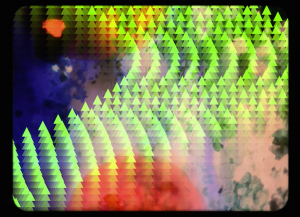 Cenote Animations is a series of psychedelic experimental video artworks. Drawing inspiration from the composer’s experiences of swimming in the cenotes (natural sink holes) of Mexico, each piece is a cenote-themed visual music hallucination of aquatic life and Mayan occultism. Cenote Zaci constructs these impressions using a combination of direct animation on 8mm film, stop-motion animation and computer graphics. The sound is also a blend of digital and analogue techniques, utilising analogue synthesis, hardware effects pedals, mezcal bottles and a shinobue purchased from a flea market.
Cenote Animations is a series of psychedelic experimental video artworks. Drawing inspiration from the composer’s experiences of swimming in the cenotes (natural sink holes) of Mexico, each piece is a cenote-themed visual music hallucination of aquatic life and Mayan occultism. Cenote Zaci constructs these impressions using a combination of direct animation on 8mm film, stop-motion animation and computer graphics. The sound is also a blend of digital and analogue techniques, utilising analogue synthesis, hardware effects pedals, mezcal bottles and a shinobue purchased from a flea market.
Biography
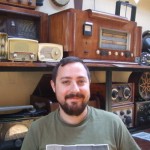 Originally from Dorset (UK), Jon Weinel is a London-based artist/researcher whose main expertise is in computer music and arts. In 2012 he completed his AHRC-funded PhD in Music at Keele University regarding the use of altered states of consciousness as a basis for composing electronic music. His work operates within the nexus of psychedelic culture and immersive computer technologies. This area is explored through a variety of interdisciplinary research and creative practice that has been published and performed internationally. Dr. Weinel is a Visiting Research Fellow in Computing at Glyndwr University.
Originally from Dorset (UK), Jon Weinel is a London-based artist/researcher whose main expertise is in computer music and arts. In 2012 he completed his AHRC-funded PhD in Music at Keele University regarding the use of altered states of consciousness as a basis for composing electronic music. His work operates within the nexus of psychedelic culture and immersive computer technologies. This area is explored through a variety of interdisciplinary research and creative practice that has been published and performed internationally. Dr. Weinel is a Visiting Research Fellow in Computing at Glyndwr University.
Ricardo Dal Farra – Organic (10:51)
 Organic, a living entity, an organism, a biological process. Continuous fluidity. Related to living matter. Derived from living matter. Organized, coherent, coordinated, integrated. Unceasing development. Elements that fit together harmoniously as part of a whole, in an endless transformation, dancing with the senses. Continuity (of life, of matter…) Variability, flexibility, smoothness. Difficulty to predict, to understand the plan, the system, the pattern, to perceive the connections.
Organic, a living entity, an organism, a biological process. Continuous fluidity. Related to living matter. Derived from living matter. Organized, coherent, coordinated, integrated. Unceasing development. Elements that fit together harmoniously as part of a whole, in an endless transformation, dancing with the senses. Continuity (of life, of matter…) Variability, flexibility, smoothness. Difficulty to predict, to understand the plan, the system, the pattern, to perceive the connections.
Organic is a generative piece of visual-music. Organic was created in 2015 using mathematical algorithms to generate the synthetic images, with the sounds derived directly from the visual analysis.
Biography
 Dr. Ricardo Dal Farra is Associate Professor at the Music Department of Concordia University, Canada and Director of the Electronic Arts Experimentation and Research Centre of the National University of Tres de Febrero, Argentina. As an electroacoustic composer and new media artist his work has been presented in more than 40 countries and recordings of his music are published in over 23 international editions (including CDs by Computer Music Journal and Leonardo Music Journal on MIT Press).
Dr. Ricardo Dal Farra is Associate Professor at the Music Department of Concordia University, Canada and Director of the Electronic Arts Experimentation and Research Centre of the National University of Tres de Febrero, Argentina. As an electroacoustic composer and new media artist his work has been presented in more than 40 countries and recordings of his music are published in over 23 international editions (including CDs by Computer Music Journal and Leonardo Music Journal on MIT Press).
He has been researcher and consultant on music & technology history for UNESCO, France; director of the Hexagram Centre for Research-Creation in Media Arts and Technologies, Canada; coordinator of the international research alliance DOCAM – Documentation and Conservation of the Media Arts Heritage; senior consultant of the Amauta – Andean Media Arts Centre in Cusco, Peru; associated researcher of the Music, Technology and Innovation Research Centre at De Montfort University, UK; and director of the Multimedia Communication national program at the Federal Ministry of Education, Argentina.
Funded by The Daniel Langlois Foundation for Art, Science and Technology of Montreal, he created the largest collection publicly available of Latin American Electroacoustic Music.
Dr. Dal Farra is the founding-director of the Understanding Visual Music conference series (Canada 2011; Argentina 2013; Brazil 2015) and the Balance-Unbalance conference series (Argentina 2010; Canada 2011; Australia 2013; USA 2015; Colombia 2016) on electronic arts and the environmental crisis. In 2015 he was the artistic director of the Mexican biennial of electronic arts, Transitio.
Joao Pedro Oliveira – Aphâr (9:00)
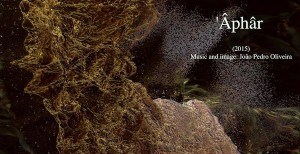 Aphâr is an Hebrew word that means “dust”.
Aphâr is an Hebrew word that means “dust”.
This video is inspired on two passages of the Old Testament:
In the beginning, God created the heavens and the earth. The earth was without form and void. (Genesis 1)
Jacob had a dream: He saw a stairway erected on the earth with its top reaching to the heavens. The angels of God were going up and coming down it and the Lord stood at its top. […] He said: Your descendants will be like the dust of the earth. (Genesis 28)
Biography
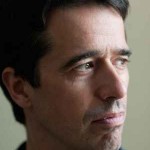 João Pedro Oliveira completed a PhD in Music at the University of New York at Stony Brook. His music includes one chamber opera, several orchestral compositions, a Requiem, 3 string quartets, chamber music, solo instrumental music, electroacoustic music and experimental video. He has received over 40 international prizes and awards, including three Prizes at Bourges Electroacoustic Music Competition, the prestigious Magisterium Prize in the same competition, the Giga-Hertz Special Award, 1st Prize in Metamorphoses competition, 1st Prize in Yamaha-Visiones Sonoras Competition, 1st Prize in Musica Nova competition, etc.. He is Professor at Federal University of Minas Gerais (Brazil) and Aveiro University (Portugal). He published several articles in journals, and has written a book about analysis and 20th century music theory.
João Pedro Oliveira completed a PhD in Music at the University of New York at Stony Brook. His music includes one chamber opera, several orchestral compositions, a Requiem, 3 string quartets, chamber music, solo instrumental music, electroacoustic music and experimental video. He has received over 40 international prizes and awards, including three Prizes at Bourges Electroacoustic Music Competition, the prestigious Magisterium Prize in the same competition, the Giga-Hertz Special Award, 1st Prize in Metamorphoses competition, 1st Prize in Yamaha-Visiones Sonoras Competition, 1st Prize in Musica Nova competition, etc.. He is Professor at Federal University of Minas Gerais (Brazil) and Aveiro University (Portugal). He published several articles in journals, and has written a book about analysis and 20th century music theory.
Martin Keary – Visual Music 01 and 02 (3:00)
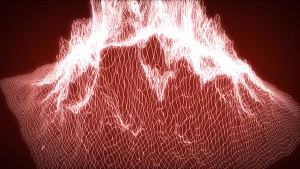 These two short pieces explore different ways that a visual-music narrative can be produced.
These two short pieces explore different ways that a visual-music narrative can be produced.
The first relies a lot on synchronous events and develops its narrative through the introduction of ever-greater amounts of 3D movement and visual complexity. The music was created to complement the technical nature of the visuals while paying homage to the electronic music genre.
The second piece allows the visuals to unfold naturally (using particle effects) and simply orbits around the result, accompanied by music that contains very little in terms of development. In this way, the music and the visuals do not burden each other with the need to ‘go anywhere’. The narrative is produced through the metaphor of a ‘source’ – the point of origin for all the particles.
Biography
I am a composer currently living in London, having just completed a masters degree in composition at the Royal Conservatoire of Scotland. Apart from my background as a composer, I am also a professional designer currently consulting at Microsoft. I am interested in the field of Visual Music because it allows me to combine my experience as a designer and composer.
As a result of winning the Craig Armstrong Prize at the the RCS (for the academic year 2014-15), I am currently composing a large-scale piece for screen and chamber orchestra, to be performed as part of the PLUG festival in Glasgow, May 2016.
Dan Tapper – Changing Signals (4:24)
 Changing Signals explores the hidden sounds of the London Tube and train network. These unheard sounds are produced electromagnetically by trains and equipment, recorded through custom-built devices – large coils of wire converting Very Low Frequency (VLF) electromagnetic radio into sound and other data.
Changing Signals explores the hidden sounds of the London Tube and train network. These unheard sounds are produced electromagnetically by trains and equipment, recorded through custom-built devices – large coils of wire converting Very Low Frequency (VLF) electromagnetic radio into sound and other data.
The piece combines these unheard sounds with footage of the machines generating them, alongside images and film of scientific objects used to analyze VLF data – oscilloscopes, spectrograms and seismographs. Changing Signals exposes a sound world that is experienced by many but never heard, revealing these sounds to the listener while hinting at the deeper scientific importance of the unheard electromagnetic flux that constantly surrounds us.
Biography
 Dan Tapper is a sonic adventurer with a passion for making the unheard audible. He has worked extensively with recording Very Low Frequency (VLF) natural radio as well as using this in an artistic context in installations, compositions and broadcast works displayed internationally.
Dan Tapper is a sonic adventurer with a passion for making the unheard audible. He has worked extensively with recording Very Low Frequency (VLF) natural radio as well as using this in an artistic context in installations, compositions and broadcast works displayed internationally.
Alongside his work with VLF, Dan is an active field recordist, spending over a year traveling through North America to collect strange and unheard sounds through a variety of DIY microphones and sensors.
Dan’s work also touches on interactivity between sound, visual and generative art, cataloging his work on the blog Code Poetry: an exploration of simple rules to create complex and beautiful images, revealing the hidden poetry of machines. His work in the area has been featured in Wired and the Creators Project.
Victoria Keddie – Helios Electro (6:26)
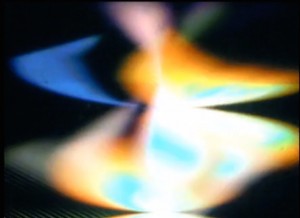 Sound and video feedback systems with signal generation. Camera halogen with monitor feedback through multi channel mixing console to create a multi layered composition involving pure feedback. Sound recorded from video systems with synced output, as well as magnetic tape recordings that have been recorded continuously and played back through localized transmission.
Sound and video feedback systems with signal generation. Camera halogen with monitor feedback through multi channel mixing console to create a multi layered composition involving pure feedback. Sound recorded from video systems with synced output, as well as magnetic tape recordings that have been recorded continuously and played back through localized transmission.
 Biography
Biography
Victoria Keddie is an artist working in sound, video, and transmission. Her focus involves analog signal generation and manipulation, the performing body, and relationships of space. For five years, she has been Co-Director of E.S.P. TV, a nomadic TV studio that hybridizes technologies to realize synthetic environments and deconstruct the televisual for live performance. In Winter 2016, Keddie launched a mobile transmission based residency operated within and involving an ENG news van. Site specific field work involves concentrated energy fields, fluctuating electronic activity, geographical discontinuity, and time sensitivity.
She has performed and exhibited internationally at venues and festivals such as, The Kitchen, Museum of Moving Image, Queens Museum of Art, and Anthology Film Archives (NYC), Carnegie Mellon University (Pittsburgh), Human Resources (Los Angeles), Lightcone, (Paris), Studio XX (Montreal), LOOP Festival (Barcelona), Pallas Projects (Dublin), Reykjavik Arts Festival (Reykjavik), General Public (Berlin), Axis Art Centre (Crew) and The 14th Independent Film Festival (Naples). With her project, E.S.P. TV, she has been artist-in-residence at Storefront for Art and Architecture and the Museum of Arts and Design.
Video works are distributed through Lightcone, (Paris). Sound works to be released in 2016 with Spectral Evidence, (Cambridge, MA).
Steven Kemper, Anna Cady, Pauline Thomas – Breath (4:00)
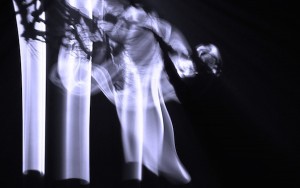
Breath is a collaboration between British filmmakers Anna Cady and Pauline Thomas and American composer Steven Kemper. It is an iteration of the Environmental Dialogues project, curated by Cady, which explores what happens when short, silent films based on elements (Earth, Fire, and Air to date) are handed over to a network of poets/writers, sound artists/musicians, and scholars, with the original soundtrack removed (www.elementaldialogues.co.uk, www.talkthinkmake.wordpress.com). Contributors produced an interpretation of these films through their own diverse practice. These interpretations were re-embedded into the film, creating new, pluridisciplinary artworks, each of which tells a different and sometimes radically unexpected story.
Kemper’s interpretation, Breath, conceives of the element Air as breath, and the composition is built around the recorded inhaling/exhaling of the composer. Different types of breathing were recorded, including short, long, powerful, and weak breaths. Exhalations were discarded, so the soundtrack uses only inhalation—drawing air and energy in. The breath sounds and processing matched the monochromatic nature of the film and the slow, undulating rhythm of movement.
Biographies
 Anna Cady is an artist who uses film, animation, photography and text in her work. Exploring the collaborative process lies at the heart of all she does; working with people who have a need to tell their story, and who find that being creative gives them not only a voice, but also hope. ‘30% (Women and Politics in Sierra Leone)’ commissioned by Real World Films was selected for the Sundance Film Festival in 2013. ‘Farms of Innocence’ was selected for Figuring Landscapes, which screened at Tate Modern in the UK and internationally. A two year project – ‘It Works Both Ways’ (made co-creatively with Louisa Makolski who could not speak or move her body voluntarily) brought Anna to the Cambridge film festival where she met Dr Jenny Chamarette with whom she now collaborates and who acted as co-curator on this project. Anna prefers to present films within site specific installations where the site lends yet another layer to the interpretation.
Anna Cady is an artist who uses film, animation, photography and text in her work. Exploring the collaborative process lies at the heart of all she does; working with people who have a need to tell their story, and who find that being creative gives them not only a voice, but also hope. ‘30% (Women and Politics in Sierra Leone)’ commissioned by Real World Films was selected for the Sundance Film Festival in 2013. ‘Farms of Innocence’ was selected for Figuring Landscapes, which screened at Tate Modern in the UK and internationally. A two year project – ‘It Works Both Ways’ (made co-creatively with Louisa Makolski who could not speak or move her body voluntarily) brought Anna to the Cambridge film festival where she met Dr Jenny Chamarette with whom she now collaborates and who acted as co-curator on this project. Anna prefers to present films within site specific installations where the site lends yet another layer to the interpretation.
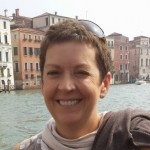 Pauline Thomas, who died in January 2016, was an international award winning artist and film make who also worked as a lecturer at Brockenhurst College and as a mental health nurse caring for the terminally ill. Her background of working with people experiencing loss in its many forms have underpinned her art practice and been fundamental to her process of exploring the sensation of time passing and the ephemeral. Over the last twelve years she has worked with the moving image, which like time is always disappearing and therefore a continuous loss. Her background in painting, an appreciation of Haiku poetry, and the Eastern aesthetic of transparency and formlessness in Japanese ink drawings have influenced her approach to filming. She was awarded numerous prizes and international residencies including The Red Mansion prize, which resulted in a two-month residency working alongside local artists in Yunnan Province, China followed by exhibitions in China and London.
Pauline Thomas, who died in January 2016, was an international award winning artist and film make who also worked as a lecturer at Brockenhurst College and as a mental health nurse caring for the terminally ill. Her background of working with people experiencing loss in its many forms have underpinned her art practice and been fundamental to her process of exploring the sensation of time passing and the ephemeral. Over the last twelve years she has worked with the moving image, which like time is always disappearing and therefore a continuous loss. Her background in painting, an appreciation of Haiku poetry, and the Eastern aesthetic of transparency and formlessness in Japanese ink drawings have influenced her approach to filming. She was awarded numerous prizes and international residencies including The Red Mansion prize, which resulted in a two-month residency working alongside local artists in Yunnan Province, China followed by exhibitions in China and London.
 Steven Kemper creates music for acoustic instruments, instruments and computers, musical robots, dance, video, and networked systems. His compositions have been performed by the Boston Modern Orchestra Project, NOW ensemble, and the Grupo Sax-Ensemble, and presented at SMC, ICMC, SEAMUS, SIGCHI, 12 Nights, Third Practice Festival, Pixilerations, American Composers Alliance Festival of American Music, and the Seoul International Computer Music Festival. Steven received a Ph.D. in composition and computer technologies from the University of Virginia, and is currently Assistant Professor of Music Technology and Composition in the Mason Gross School of the Arts at Rutgers, The State University of New Jersey.
Steven Kemper creates music for acoustic instruments, instruments and computers, musical robots, dance, video, and networked systems. His compositions have been performed by the Boston Modern Orchestra Project, NOW ensemble, and the Grupo Sax-Ensemble, and presented at SMC, ICMC, SEAMUS, SIGCHI, 12 Nights, Third Practice Festival, Pixilerations, American Composers Alliance Festival of American Music, and the Seoul International Computer Music Festival. Steven received a Ph.D. in composition and computer technologies from the University of Virginia, and is currently Assistant Professor of Music Technology and Composition in the Mason Gross School of the Arts at Rutgers, The State University of New Jersey.
Tonali Rufino and Emilio Hernández Cortés – Raw Maze (7:02)
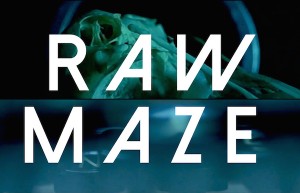 Raw maze discovers a found window in civilization forms, like memory, mortality and uncertainty, that take off from the finitude. Here we are submerged in a post-memory phase, where the speech proposes a development of an anachronistic narrative from a basic form of human history, connected to their rationality and society construction, a raw maze created by both, human nature and social structure.
Raw maze discovers a found window in civilization forms, like memory, mortality and uncertainty, that take off from the finitude. Here we are submerged in a post-memory phase, where the speech proposes a development of an anachronistic narrative from a basic form of human history, connected to their rationality and society construction, a raw maze created by both, human nature and social structure.
Biographies
 Tonalli Rufino Nakamura, Mexican composer born in 1991, has taken clases with composers like Hebert Vázquez, German Romero, Kevin Patton, Ken Ueno and Ricardo Climent, member of Andamio colective who has premiered pieces in Mexico, South America and in the USA.
Tonalli Rufino Nakamura, Mexican composer born in 1991, has taken clases with composers like Hebert Vázquez, German Romero, Kevin Patton, Ken Ueno and Ricardo Climent, member of Andamio colective who has premiered pieces in Mexico, South America and in the USA.
Third place winer of the composition contest in the international festival of contemporary music VI of Morelia in 2010, Worked as a composer in several dance companies, Composer of the video-game company Fugitive Pixel in 2011- 2012 launching two videogames for iOS, Internship of “Visiones Sonoras 2012 and 2013” and worker at CMMAS (Centro mexicano para la musica y las nuevas tecnologias/Mexican Center for music and new tecnologies).
Emilio Hernández Cortés studied Visual Arts at the Faculty of Arts of the U.M.S.N.H. with a degree in Art and new technologies; He has conducted academic activities included in the study Film, Image- movement and Video-art. He has participated in various programs covering film theory, discourse analysis in cinema, multimedia performing arts, etc. He has worked in film festivals, photography and video art. Interested in production, research and film.
Vishal Shah – Vellum (3:58)
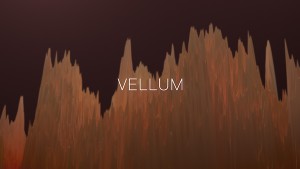 Vellum is a moving sound sculpture. Projected 2D double images are aesthetically 3D extruded and in constant rotation. The plateau of each extrusion is either hidden or limited, holding and composing the pictorial plane. Movements are fast and slow turning into sculptural islands to the sound of an improvised double bass. Vellum is beautiful in detail and timely in each movement. Vellum becomes a mesmerising work to see and hear.
Vellum is a moving sound sculpture. Projected 2D double images are aesthetically 3D extruded and in constant rotation. The plateau of each extrusion is either hidden or limited, holding and composing the pictorial plane. Movements are fast and slow turning into sculptural islands to the sound of an improvised double bass. Vellum is beautiful in detail and timely in each movement. Vellum becomes a mesmerising work to see and hear.
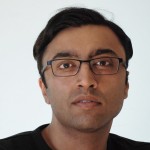 Biography
Biography
Vishal is an art director with hands-on visual and motion design experience. Originally from London he lives and works in Berlin. Currently Vishal is the art director at DCMN D.C. Media Networks GmbH, a communications and media agency for digital commerce companies across Europe.
Vishal is a forward thinking individual with a strong contemporary and historical knowledge base and practise of art, design and media. With a multi-disciplinary outlook and cross-pollination ethos, he accomplished eight years (2003 -2011) as a visiting lecturer at the Royal College of Art and as an Adjunct Professor at Richmond, The American International University in London, whilst he was concurrently working as a designer and motion artist supporting London-based agencies. Independently Vishal directs and produces moving image work for international screenings and visual music events across Europe, America and Asia.
Nick Cope, Tim Howle – Flags 3 (10:00)
 The third incarnation of this work builds on a single monitor work originally presented at a festival celebrating the work of Cornelius Cardew featuring a single shot of Tibetan Buddhist prayer flags filmed on a hillside at Ganden Monastery, near Lhasa, Tibet. A second version of the work introduced a second shot juxtaposed with the first from prayer flags shot by Namtso Lake, Tibet, and an additional working of the sound. This version introduces a third location and a third strand of sound, designed specifically for the Seeing Sound Symposium. Composer, Tim Howle, has written previously of the work that sonically the approach attempts limited levels of intervention that chime with the images. The exploitation of the inherent musicality of the images emphasises timelessness and continuity through an improvisational approach, mirroring and counterpointing objects in the image. The limited indeterminate relationship of the layers of musical material allows for shifts with regard to each other, resulting in harmonious and gestural relationships regardless of juxtaposition. Sounds are selected from a limited palette.
The third incarnation of this work builds on a single monitor work originally presented at a festival celebrating the work of Cornelius Cardew featuring a single shot of Tibetan Buddhist prayer flags filmed on a hillside at Ganden Monastery, near Lhasa, Tibet. A second version of the work introduced a second shot juxtaposed with the first from prayer flags shot by Namtso Lake, Tibet, and an additional working of the sound. This version introduces a third location and a third strand of sound, designed specifically for the Seeing Sound Symposium. Composer, Tim Howle, has written previously of the work that sonically the approach attempts limited levels of intervention that chime with the images. The exploitation of the inherent musicality of the images emphasises timelessness and continuity through an improvisational approach, mirroring and counterpointing objects in the image. The limited indeterminate relationship of the layers of musical material allows for shifts with regard to each other, resulting in harmonious and gestural relationships regardless of juxtaposition. Sounds are selected from a limited palette.
“Devout Tibetans believe that prayer flags literally bless the air passing through them with sacred mantra prayers – these prayers then waft past beings unknowingly caught up in the cyclical wheel of suffering known as samsara. Such blessed air, it is said, has a calming effect on these unhappy beings, nudging them infinitesimally closer to the liberating teachings of the Buddha with every breath. The very presence of prayer flags in your vicinity, therefore, will eventually cause you to take an interest in Buddhism. Or such is a literal interpretation.” Wise, T. (2002) Blessings on the Wind. San Francisco, Chronicle Books.
 Biographies
Biographies
Tim Howle is Professor of Contemporary Music at University of Kent. He has previously held posts at Hull and Oxford Brookes Universities. He read music at Keele University, studying under Roger Marsh and Mike Vaughan, and completing a doctorate in composition in 1999. His work focuses on sonic art including fixed media pieces, live electronics, and audio-visual compositions. Nick Cope is Associate Professor in Communication Studies and Head of Humanities & Social Sciences at Xi’an Jiaotong-Liverpool University, Suzhou, China; previously working for the Universities of Sunderland, Hull and Southampton Solent. He has been a practicing film, video and digital media artist since 1982, and completed a PhD by Existing Creative Published Work in October 2012. This locates a contemporary visual music practice within current and emerging critical and theoretical contexts and tracks back the history of this practice to initial screenings of work as part of the 1980s British Scratch video art movement, and later collaborations with electronic music pioneers Cabaret Voltaire and others. Work has been screened nationally and internationally since the 1980s. Collaborating with composer Professor Tim Howle since 2002, this work has been screened and presented and papers given relating to the collaboration at conferences, concerts, galleries and festivals, nationally and internationally.